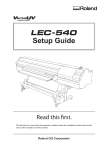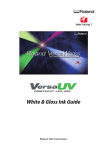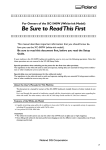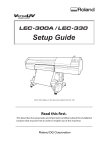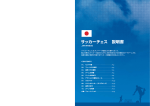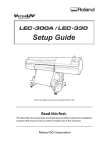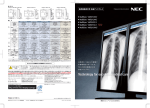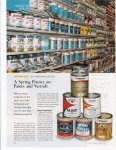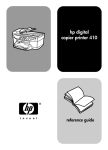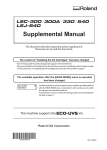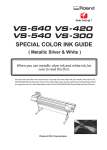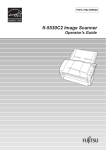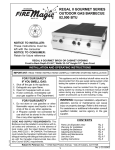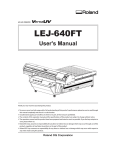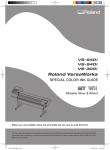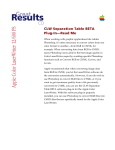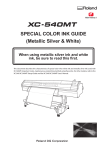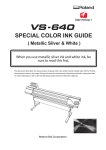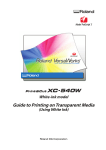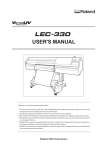Download White & Gloss Ink Guide
Transcript
White & Gloss Ink Guide LEC-540_USE2_EN.indb 1 2013/10/18 16:58:32 Thank you very much for purchasing this product. To ensure correct and safe usage with a full understanding of this product's performance, please be sure to read through this manual completely and store it in a safe location. Unauthorized copying or transferral, in whole or in part, of this manual is prohibited. The contents of this operation manual and the specifications of this product are subject to change without notice. The operation manual and the product have been prepared and tested as much as possible. If you find any misprint or error, please inform us. Roland DG Corp. assumes no responsibility for any direct or indirect loss or damage which may occur through use of this product, regardless of any failure to perform on the part of this product. Roland DG Corp. assumes no responsibility for any direct or indirect loss or damage which may occur with respect to any article made using this product. LEC-540_USE2_EN.indb 2 2013/10/18 16:58:32 Contents Contents.........................................................................................................1 Chapter 1 Getting Started....................................................................................3 1-1 What This Document Assumes and Related Manuals.............................4 What This Document Assumes..................................................................................................... 4 Related Manuals................................................................................................................................ 4 VersaWorks Online............................................................................................................................ 5 1-2 White Ink Features and Printing Methods................................................6 Features of White Ink........................................................................................................................ 6 Methods of Printing Using White Ink......................................................................................... 6 1-3 Gloss Ink Features and Printing Methods................................................7 Features of Gloss Ink......................................................................................................................... 7 Methods of Printing Using Gloss Ink.......................................................................................... 7 Chapter 2 Getting Ready......................................................................................9 2-1 Printer Preparations...............................................................................10 Making the Printer Settings and Loading Media.................................................................10 2-2 Preparing VersaWorks........................................................................... 11 Starting VersaWorks........................................................................................................................11 Creating a Folder for Saving PS Files........................................................................................11 2-3 Preparing Printing Data..........................................................................12 Basic Approach for Creating Printing Data............................................................................12 Creating Data for Printing............................................................................................................12 Chapter 3 Printing...............................................................................................19 3-1 Introduction............................................................................................20 Before You Start Printing...............................................................................................................20 Print Modes.......................................................................................................................................20 3-2 Printing Using White or CMYK Color Inks..............................................22 Printing White and CMYK Color Inks in a Single-Pass........................................................22 Printing Using Only White Ink.....................................................................................................26 Printing Using Only CMYK Inks...................................................................................................28 3-3 Printing Using Gloss Ink.........................................................................30 Gloss-finish Printing (White or CMYK Colors Gloss).......................................................30 Matte-finish Printing (White or CMYK Colors Gloss).....................................................32 Matte-finish Printing (Single-pass CMYK and Gloss Printing).........................................34 Embossed-finish Printing (White or CMYK Colors Gloss).............................................36 Printing Using Only Gloss Ink......................................................................................................41 Chapter 4 Advanced...........................................................................................43 4-1 More Advanced Printing Settings...........................................................44 Making Printing Settings for Each Job.....................................................................................44 4-2 More Advanced Printing Data Creation..................................................45 White or CMYK Colors Gloss: When You Want Keep Changes in Settings to a Minimum...45 4-3 Creating Decals (Cutting after Printing).................................................50 Overview of Decal Creation.........................................................................................................50 Creating Decals Through Printing Using CMYK Color Inks or White Ink......................50 Creating Decals Through Printing Using Gloss Ink..............................................................50 4-4 Composing Printing Data.......................................................................51 Composing Printing Data Containing Only CMYK Colors or Containing Only White (or Gloss)....51 1 LEC-540_USE2_EN.indb 1 2013/10/18 16:58:32 Contents 4-5 Performing Texture Printing...................................................................56 What is Texture Printing?..............................................................................................................56 Printing a Texture Chart................................................................................................................56 Create The Texture Printing Data...............................................................................................58 Performing Texture Printing........................................................................................................64 This document is the user's manual for VersaUV series. Most of the figures in this document depict the LEC-540. Copyright and property of this Software and this manual belong to Roland DG Corp. No part of this publication may be reproduced, stored in a retrieval system or transmitted, in any from or by any means, electronic, mechanical, photocopy, recording or otherwise, without the prior written permission of the publisher. VersaWorks is a registered trademark of Roland DG Corp. Windows is a registered trademarks or trademarks of Microsoft® Corporation in the United States and/or other countries. Pentium are registered trademarks of Intel Corporation in the United States. Macintosh is a registered trademark of Apple Inc. Adobe, the Adobe logo, PostScript, PostScript 3, and Illustrator are either registered trademarks or trademarks of Adobe Systems Incorporated in the United States and/or other countries. ©2007 Adobe Systems Incorporated. All rights reserved. Other company names and product names are trademarks or registered trademarks of their respective holders. Copyright © 2010-2013 Roland DG Corporation http://www.rolanddg.com/ 2 LEC-540_USE2_EN.indb 2 2013/10/18 16:58:32 Chapter 1 Getting Started 1-1 What This Document Assumes and Related Manuals..............4 What This Document Assumes....................................................4 Related Manuals...........................................................................4 VersaWorks Online.......................................................................5 1-2 White Ink Features and Printing Methods................................6 Features of White Ink...................................................................6 Methods of Printing Using White Ink............................................6 1-3 Gloss Ink Features and Printing Methods................................7 Features of Gloss Ink...................................................................7 Methods of Printing Using Gloss Ink............................................7 3 LEC-540_USE2_EN.indb 3 2013/10/18 16:58:33 1-1 What This Document Assumes and Related Manuals What This Document Assumes Before performing any operations described in this guide, make sure that all the following preparations are complete. Assembling and installing VersaUV series printers Installing VersaWorks on your computer, and connecting the computer to the VersaUV series via a network Related Manuals Read the following documentation for information about setting up the VersaUV series printer and VersaWorks. Setup Guide ( First Step Guide for LEF-12, LEF-20 ) This manual covers details about how to use the VersaUV series, including how to set up the printer and where to locate the printer, etc. Be sure to read this manual. ( Up to "First Time Printing" is explained for LEF-12, LEF-20. ) User's Manual ( MASTER GUIDE for LEF-12, LEF-20 ) This manual describes operation methods in detail. After you've read the VersaUV series Setup Guide, be sure to read this manual. VersaWorks Quick Start Guide This manual explains basic operations of VersaWorks, including how to set up the program. Be sure to read Chapter 1 of this manual and make necessary setups on your computer. After you've read the VersaUV series User’s Manual, be sure to read this manual. It is also recommended to read Chapter 2 of this manual and become familiar with how to use this program. 4 LEC-540_USE2_EN.indb Chapter 1 Getting Started 4 2013/10/18 16:58:33 1-1 What This Document Assumes and Related Manuals VersaWorks Online This document describes basic procedures to perform printing using white ink and gloss ink. Of course, methods of printing using white or gloss ink other than the ones in this document are also available. You can use Illustrator's transparency features, or perform other special printing operations not covered in this document. You can get information on these advanced printing methods and the latest information about VersaWorks by viewing VersaWorks Online. If you want to learn more about the features of VersaWorks, or if you want to use white or gloss ink more effectively, be sure to visit VersaWorks Online. VersaWorks Online: http://dg4.roland.co.jp/en/RVW2forWeb/index.html VersaWorks Online can be displayed by clicking [Help] and [VersaWorks Online] from the Main menu. Chapter 1 Getting Started LEC-540_USE2_EN.indb 5 5 2013/10/18 16:58:33 1-2 White Ink Features and Printing Methods Features of White Ink The exclusive white ink that this printer uses achieves high density and concealment, and is capable of providing attractive results when white and CMYK colors are overprinted. This ink is suited to printing on transparent media, and can be used it to create items for shop interiors and displays, PET bottles and other packages, decals, and more. Methods of Printing Using White Ink Printing using white and CMYK ink When you're printing using white and CMYK color inks, this printer runs the areas that use the white ink and the CMYK color inks simultaneously, in a single pass, so stable, highly intricate printing having no misalignment due to feed is possible. When you're printing using transparent media, you can create results intended to be viewed from the back (the side opposite the printed surface) by reversing the image and changing the sequence in which white and CMYK colors are printed. P. 22, "Printing White and CMYK Color Inks in a Single-Pass" Printing White Only or CMYK Colors Only You can also perform printing using only white ink or only CMYK color inks. To display the side opposite the printed surface, you can take such action as printing a mirror image of the artwork. P. 26, "Printing Using Only White Ink" P. 28, "Printing Using Only CMYK Inks" 6 LEC-540_USE2_EN.indb Chapter 1 Getting Started 6 2013/10/18 16:58:33 1-3 Gloss Ink Features and Printing Methods Features of Gloss Ink The exclusive Gloss ink that this printer uses is colorless and transparent, and can impart a glossy feel to the printed item, as well as enhancing weatherability and robustness.* Also, depending on the printing settings, you can even deliberately eliminate glossiness and produce a matte finish, or perform fill overprinting using gloss ink to raise the printed surface and create an embossed finish. * Glossiness, weatherability, and robustness may vary depending on the media used, the environment, and other printing conditions. Methods of Printing Using Gloss Ink Gloss-finish Printing This printing method imparts a glossy finish to the printed item. Forming a coating of gloss ink imparts a glossy finish and can also achieve high weatherability and robustness. When you're overprinting an item already printed using white or CMYK color inks, you pull back the printed item and perform fill overprinting with gloss ink. P. 30, "Gloss-finish Printing (White or CMYK Colors Gloss)" Printing using only gloss ink is also possible. P. 41, "Printing Using Only Gloss Ink" Matte-finish Printing This printing method eliminates glossiness and produces a restful matte finish. This perform fill overprinting of white and CMYK colors with gloss ink, which makes it possible to produce results where glossiness is suppressed while weatherability and robustness are enhanced. When you're using white ink to overprint an item already printed using white or CMYK color inks, you pull back the printed item and perform fill overprinting with gloss ink. P. 32, "Matte-finish Printing (White or CMYK Colors Gloss)" When you're not using white ink, CMYK color inks and gloss ink are applied in one pass; there is no need to pull back the printed item. P. 34, "Matte-finish Printing (Single-pass CMYK and Gloss Printing)" Printing using only gloss ink is also possible. P. 41, "Printing Using Only Gloss Ink" Embossed-finish Printing This printing method can produce items that have a three-dimensional feel by performing fill overprinting of the item using gloss ink. You determine the height to which the printed surface is raised by setting the number of fill-overprint passes in VersaWorks. After performing fill-overprinting by this specified number of passes, the item is overprinted one last time using gloss ink to produce a gloss finish. When you're overprinting an item already printed using white or CMYK color inks, you pull back the printed item and perform fill overprinting with gloss ink. P. 35, "Embossed-finish Printing (White or CMYK Colors Gloss)" Printing using only gloss ink is also possible. P. 41, "Printing Using Only Gloss Ink" Chapter 1 Getting Started LEC-540_USE2_EN.indb 7 7 2013/10/18 16:58:33 8 LEC-540_USE2_EN.indb 8 2013/10/18 16:58:33 Chapter 2 Getting Ready 2-1 Printer Preparations................................................................10 Making the Printer Settings and Loading Media.........................10 2-2 Preparing VersaWorks............................................................ 11 Starting VersaWorks...................................................................11 Creating a Folder for Saving PS Files........................................11 2-3 Preparing Printing Data..........................................................12 Basic Approach for Creating Printing Data.................................12 Creating Data for Printing...........................................................12 9 LEC-540_USE2_EN.indb 9 2013/10/18 16:58:33 2-1 Printer Preparations Making the Printer Settings and Loading Media When Using Transparent Media (LEC-300A / 330 / 540, LEJ-640) When you're using transparent media, make the necessary printing settings on the printer and load the media accordingly. Procedure Press menu on the printer and make the following settings. For LEC-330A / 330 / 540 Set [EDGE DETECTION] to "DISABLE." For LEJ-640 Set [SHEET TYPE] to "CLEAR." Load transparent media into the printer. When the media you are loading into the printer warps or partially floats from the platen, load it into the printer so that its front end goes about 20 cm (8 in.) from the starting edge of the print area. Be sure to use the media clamps when you load media. When Using Media Other Than Transparent Media (LEC-300A / 330 / 540, LEJ-640) Load the media using the method described in the User's Manual * In the case of LEF-12 and LEF-20, make the printer setting and load the media in accordance with the supplied documentation. 10 LEC-540_USE2_EN.indb Chapter 2 Getting Ready 10 2013/10/18 16:58:33 2-2 Preparing VersaWorks Starting VersaWorks Start VersaWorks on the computer you're using. Procedure From the [Start] menu, click [All programs (or Programs)] - [Roland VersaWorks] - [Roland VersaWorks]. Main window appears. Check to make sure that "Model (or Nickname) of Your Printer" is displayed on the upper left of the main screen, and that "Status" is set to "Ready to Print." Creating a Folder for Saving PS Files Before you actually print an image you draw using application software such as Adobe Illustrator, it is necessary to save the image as a PS file (s). And then, you can print the image by loading the PS file (s) on VersaWorks. Because of this, you should create a folder for saving PS files in advance. It is recommended to locate the folder in the root directory on your computer's local disk. Procedure Open [Computer] (or [My Computer]), and then open [Local Disk (C:)]. Create a new folder. Click [File] , [Create New], and then [Folder], or click "New Folder" from the menu. Name the created new folder. Here you name the folder "White-gloss_print", for example. Chapter 2 Getting Ready LEC-540_USE2_EN.indb 11 11 2013/10/18 16:58:33 2-3 Preparing Printing Data Basic Approach for Creating Printing Data When you want to print using white ink Apply the spot color named "RDG_WHITE" to the areas you want to print using white ink. When you want to print using gloss ink Apply the spot color named "RDG_GLOSS" to the areas you want to print using gloss ink. Creating Data for Printing Create the data for printing using white ink and gloss ink. The program used to create the printing data is Adobe Illustrator CS6. For detailed information on drawing methods and how to work with palettes, refer to the documentation or online help for Adobe Illustrator CS6. If you're using another version of Adobe Illustrator, operations may be somewhat different from those explained here. 1. 12 LEC-540_USE2_EN.indb Open the exclusive swatch library At the swatch palette menu, select [Open Swatch Library], then [Other Library]. The "Select a Library to open" window appears. *The swatch palette is displayed by going to the menu and selecting [Window], then [Swatch]. Chapter 2 Getting Ready 12 2013/10/18 16:58:33 2-3 Preparing Printing Data Open folder in the order of [Computer] (or [My Computer]) → [Local Disk (C:)] → [Program Files] → [Roland VersaWorks] → [Swatch] → [Illustrator], then select "Roland VersaWorks.ai." Depending on the settings of your computer, the extension ."ai" might not be shown. Click [Open]. The swatch library containing "RDG_WHITE" and "RDG_GLOSS" is displayed. By saving the ".ai" file selected in steps into the folder below, you can register each swatch library to the Adobe Illustrator's library. Once the registration is performed, you can open the library directly from the swatch palette menu, eliminating the need to search the file every time you start Adobe Illustrator. C:\Program Files\Adobe\Adobe Illustrator CS6\Presets\(language abbreviation)\Swatches *"C" is the name of your computer's local disk. *The language abbreviation differs depending on the language used. *Depending on the Illustrator used, "\Preset\Swatch" may be used instead of "\Presets\(language abbreviation)\Swatch" is "\Preset\Swatch." 2. Create the illustration, and specify the spot color that matches the color you want to print. Create the illustration. Note: Be sure to draw the illustration in the CMYK mode. Continued on the next page Chapter 2 Getting Ready LEC-540_USE2_EN.indb 13 13 2013/10/18 16:58:34 2-3 Preparing Printing Data Specify each spot color that matches the color you want to print. Desired ink or color Spot color name White ink RDG_WHITE Gloss ink RDG_GLOSS Specify "RDG_GLOSS" for the areas where you want to use gloss ink. Specify "RDG_WHITE" for the areas where you want to use white ink 14 LEC-540_USE2_EN.indb Chapter 2 Getting Ready 14 2013/10/18 16:58:34 2-3 Preparing Printing Data 3. Create the PS (PostScript) file. Select [Print] from the [File] menu. Select [RolandVW]. Click [Setup]. Click [Continue]. Continued on the next page Chapter 2 Getting Ready LEC-540_USE2_EN.indb 15 15 2013/10/18 16:58:34 2-3 Preparing Printing Data Turn on the [Print to file] option. Click [Preferences]. Click [Advanced] in the [Layout] tab. Click the down arrow to the right of the [Paper Size] box, and then click [PostScript Custom Page Size] from the list that appears. For "Custom Page Size Dimensions," enter the values in the "Width" and "Height" fields. Enter values for the same size as the illustration you created in step 2. 16 LEC-540_USE2_EN.indb Chapter 2 Getting Ready 16 2013/10/18 16:58:34 2-3 Preparing Printing Data Click [OK] three times to close the "PostScript Custom Page Size Definition," "Roland VersaWorks Advanced Options," and "Printing Preferences" dialog boxes. The "Print" dialog box returns. Click [Print]. Click [Print]. Specify the destination and file name. Select the folder you created in P. 11, "Creating a Folder for Saving PS Files". Example: " C:¥white-gloss_print " for the folder to save to, and " label_white-glossprint.ps " as the file name Click [Save]. The CMYK layer of the image is saved as a PS file. Assign the name you want. It may be a good idea to assign a name that indicates that the file uses white and gloss ink. Open the folder you saved to and make sure the file has been created. Chapter 2 Getting Ready LEC-540_USE2_EN.indb 17 17 2013/10/18 16:58:35 18 LEC-540_USE2_EN.indb 18 2013/10/18 16:58:35 Chapter 3 Printing 3-1 Introduction.............................................................................20 Before You Start Printing............................................................20 Print Modes................................................................................20 3-2 Printing Using White or CMYK Color Inks..............................22 Printing White and CMYK Color Inks in a Single-Pass..............22 Printing Using Only White Ink.....................................................26 Printing Using Only CMYK Inks..................................................28 3-3 Printing Using Gloss Ink.........................................................30 Gloss-finish Printing (White or CMYK Colors Gloss)..............30 Matte-finish Printing (White or CMYK Colors Gloss)..............32 Matte-finish Printing (Single-pass CMYK and Gloss Printing)....34 Embossed-finish Printing (White or CMYK Colors Gloss)......36 Printing Using Only Gloss Ink.....................................................41 19 LEC-540_USE2_EN.indb 19 2013/10/18 16:58:35 3-1 Introduction Before You Start Printing Remove just the white ink cartridge, shake the cartridge 50 times (about 15 seconds), then reinsert it. Shaking each time is unnecessary for the ink cartridges other than the white one. However, when installing new ink cartridges, be sure to shake them. The precipitation of the ingredients in the ink disables printing in normal color. To allow the ingredients to be mixed well, shake each ink cartridge horizontally from side to side by 5 cm (2 inches) from each end of the ink cartridge. The ingredients in white ink tend to settle. Each day, before starting the day's operations,be sure to carry out the above steps. Allowing the ink to stand without carrying out these steps can cause the settled material to harden, resulting in malfunction or other problems. Print Modes When you're printing on media in this machine, you need to set print mode based on the type of ink, printing method (single-pass, white only, CMYK only, glossy finish, matte finish, embossed finish), and the side from which printed image is seen (image seen from printed surface, image seen from opposite side of printed surface). This section gives a brief overview of each type of print mode. 20 LEC-540_USE2_EN.indb Print mode Overview Page White -> CMYK, or White -> CMYK (v) This print mode is for single-pass printing. Printing of white data and CMYK color data is performed in a single pass, but the sequence is such that the white ink is overprinted by the CMYK color inks. P. 23 CMYK -> White, or CMYK -> White (v) This print mode is for single-pass printing. Printing of white data and CMYK color data is performed in a single pass, but the sequence is such that the CMYK color inks are overprinted by the white ink. P. 24 White, or White (v) This mode is for printing white color data only. P. 26 CMYK, or CMYK (v) This mode is for printing CMYK color data only. P. 28 Chapter 3 Printing 20 2013/10/18 16:58:35 3-1 Introduction GlossVarnish (v) This print mode is for glossy finish on the printed item. After performing printing using white and CMYK color data, it pulls back the media, then performs fill overprinting using gloss ink. This mode can also be printed using only gloss ink.(*) MatteVarnish (v) This print mode is for matte finish on the printed item. After performing printing using white and CMYK color data, it pulls back the media, then performs overprinting using gloss ink. This mode can also be printed using only gloss ink.(*) P. 32 (*)P. 41 CMYK -> MatteVarnish, or CMYK -> MatteVarnish (v) This print mode is for matte finish on the printed item. Printing of gloss ink and CMYK color data is performed in a single pass, but the sequence is such that the CMYK color inks are overprinted by the gloss ink. P. 34 Embossing (v) This print mode is for embossed finish by raising the printed surface through fill overprinting using gloss ink. After performing printing using white and CMYK color data, it pulls back the media, then performs overprinting using gloss ink This mode can also be printed using only gloss ink.(*) P. 35 (*)P. 41 Chapter 3 Printing LEC-540_USE2_EN.indb 21 P. 30 (*)P. 41 21 2013/10/18 16:58:35 3-2 Printing Using White or CMYK Color Inks Printing White and CMYK Color Inks in a Single-Pass This section describes how to perform printing using both white ink and CMYK color inks. This method prints CMYK color data and white data in a single pass, but you vary the printing settings depending on how the finished results are you be viewed (the printed surface or the side opposite the printed surface) and on which type of ink is the undercoat. Procedure Make sure that you have finished making the preparations for VersaWorks, creating the printing data, and getting the printer ready ( P. 9, "Chapter 2 Getting Ready"). Double-click At the "Queue A Properties" window, make the basic settings for printing. . "Queue A Properties" window appears. Clicking an icon on the left side of the window switches what is displayed on the right side. Refer to the table following and make the settings for the respective items. After making the settings, click [OK] Close the "Queue A Properties" window. 22 LEC-540_USE2_EN.indb Chapter 3 Printing 22 2013/10/18 16:58:35 3-2 Printing Using White or CMYK Color Inks When You Want to Display the Printed Surface of the Finished Results (White Ink Undercoat) Transparent media, etc. You will have the printed image from this side (the printed surface of the finished results). White CMYK Note: The white and the CMYK color inks are printed in a single-pass, but are shown here as separate layers in order to indicate the printing sequence. Icon (*2) ( Not used for LEF-12 and LEF-20 ) Setting Item Setting Mirror Off Media Type Generic, Generic High-opacity White (*1), or Generic Distance (*3) Mode White -> CMYK, or White -> CMYK (v) (*4) Operation Mode Print Only Return to Origin After Print Off (*1) About "Generic High-opacity White" It makes possible output of white of higher opacity than "Generic." This option can be selected only in the case that the ink type is ECO-UV CMYKWW or ECO-UV3 CMYKWW , which uses two white ink cartridges in addition to cyan, magenta, yellow, and black ECO-UV or ECO-UV3 ink cartridges. It cannot be used when you use ECO-UVS ink. (*2) In case using LEF-12 when you print on a media of which has uneven print surface, set the Print Quality to "Distance." (*3) In case using LEF-20 when you print on a media of which has uneven print surface, set the Media Type to "Generic Distance." (*4) When you want to make CMYK color inks the undercoat, even in cases you want to display the printed surface of the finished results to be the surface displayed, select the "CMYK -> White" or "CMYK -> White (v)" setting. Chapter 3 Printing LEC-540_USE2_EN.indb 23 23 2013/10/18 16:58:36 3-2 Printing Using White or CMYK Color Inks When You Want to Display the Side Opposite the Printed Surface of the Finished Results (CMYK Undercoat) Transparent media, etc. You will have the printed image from this side (the opposite side of the printed surface of the finished results). CMYK White Note: The white ink and the CMYK color inks are printed in a single-pass, but are shown here as separate layers in order to indicate the printing sequence. Icon (*2) ( Not used for LEF-12 and LEF-20 ) Setting Item Setting Mirror On Media Type Generic, Generic High-opacity White (*1), or Generic Distance (*3) Mode CMYK -> White, or CMYK -> White (v) (*4) Operation Mode Print Only Return to Origin After Print Off (*1) About "Generic High-opacity White" It makes possible output of white of higher opacity than "Generic. This option can be selected only in the case that the ink type is ECO-UV CMYKWW or ECO-UV3 CMYKWW, which uses two white ink cartridges in addition to cyan, magenta, yellow, and black ECO-UV or ECO-UV3 ink cartridges. It cannot be used when you use ECO-UVS ink. (*2) In case using LEF-12 when you print on a media of which has uneven print surface, set the Print Quality to "Distance." (*3) In case using LEF-20 when you print on a media of which has uneven print surface, set the Media Type to "Generic Distance." (*4) When you want to make the white ink undercoat, even in cases the side opposite the printed surface of the finished results is to be the surface displayed, select the "White -> CMYK" or "White -> CMYK (v)" setting. 24 LEC-540_USE2_EN.indb Chapter 3 Printing 24 2013/10/18 16:58:36 3-2 Printing Using White or CMYK Color Inks Go to "Job List" and click the "Queue A" tab. Drag the print job you created in P. 12, to the queue A job list. "Creating Data for Printing" The contents of the file are displayed in the preview window, and the layout on the media is displayed in the layout window. Areas using "RDG_WHITE" are displayed with shading in transparent magenta. If the areas using "RDG_WHITE" are not displayed with shading, the settings of "Mode" is incorrect. Go back to the procedure and select the correct mode. Click . Printing will be started. Chapter 3 Printing LEC-540_USE2_EN.indb 25 25 2013/10/18 16:58:36 3-2 Printing Using White or CMYK Color Inks Printing Using Only White Ink Procedure Make sure that you've finished making the preparations for VersaWorks and getting the printer ready ( P. 9, "Chapter 2 Getting Ready"). Prepare the printing data. Using a program such as Adobe Illustrator, create the data for printing white only. When creating the data, remember to specify "RDG_WHITE" as the color. P. 12, "Creating Data for Printing" Make the settings in the "Queue A Properties" window. Double-click , and in the "Queue A Properties" window that appears, make the basic settings for printing as shown following. Icon (*3) ( Not used for LEF-12 and LEF-20 ) Setting Item Setting Mirror (*1) Media Type Generic, Generic High-opacity White (*2), or Generic Distance (*4) Mode White, or White (v) Operation Mode Print Only Return to Origin After Print Off (*1) When showing the finished printing from the printed surface: Uncheck the box. When showing the finished printing from the opposite side of the printed surface: Check the box. (*2) "Generic High-opacity White" It makes possible output of white of higher opacity than "Generic". This option can be selected only in the case that the ink type is ECO-UV CMYKWW or ECO-UV3 CMYKWW, which uses two white ink cartridges in addition to cyan, magenta, yellow, and black ECO-UV or ECO-UV3 ink cartridges. It cannot be used when you use ECO-UVS ink. (*3) In case using LEF-12 when you print on a media of which has uneven print surface, set the Print Quality to "Distance." (*4) In case using LEF-20 when you print on a media of which has uneven print surface, set the Media Type to "Generic Distance." After making the settings, click [OK] to close the "Queue A Properties" window. 26 LEC-540_USE2_EN.indb Chapter 3 Printing 26 2013/10/18 16:58:36 3-2 Printing Using White or CMYK Color Inks Go to "Job List" and click the "Queue A" tab. Drag the print job you created in P. 12, to the queue A job list. "Creating Data for Printing" The contents of the file are displayed in the preview window, and the layout on the media is displayed in the layout window. Areas using "RDG_WHITE" are displayed with shading in transparent magenta. If the areas using "RDG_WHITE" are not displayed with shading, the settings of "Mode" is incorrect. Go back to the procedure and select the correct mode. Click . Printing will be started. Chapter 3 Printing LEC-540_USE2_EN.indb 27 27 2013/10/18 16:58:36 3-2 Printing Using White or CMYK Color Inks Printing Using Only CMYK Inks Procedure Make sure that you've finished making the preparations for VersaWorks and getting the printer ready ( P. 9, "Chapter 2 Getting Ready"). Prepare the printing data. Make the settings in the "Queue A Properties" window. Using a program such as Adobe Illustrator, create the data for printing CMYK colors only. Double-click , and in the "Queue A Properties" window that appears, make the basic settings for printing as shown following. Icon (*3) ( Not used for LEF-12 and LEF-20 ) Setting Item Setting Mirror (*1) Media Type Generic, Generic High-opacity White (*2), or Generic Distance (*4) Mode CMYK, or CMYK (v) Operation Mode Print Only Return to Origin After Print Off (*1) When showing the finished printing from the printed surface: Uncheck the box. When showing the finished printing from the opposite side of the printed surface: Check the box. (*2) About "Generic High-opacity White" The output results are the same whether "Generic" or "Generic High-opacity White" is selected. This option can be selected only in the case that the ink type is ECO-UV CMYKWW or ECO-UV3 CMYKWW, which uses two white ink cartridges in addition to cyan, magenta, yellow, and black ECO-UV or ECO-UV3 ink cartridges. It cannot be used when you use ECO-UVS ink. (*3) In case using LEF-12 when you print on a media of which has uneven print surface, set the Print Quality to "Distance." (*4) In case using LEF-20 when you print on a media of which has uneven print surface, set the Media Type to "Generic Distance." After making the settings, click [OK] to close the "Queue A Properties" window. 28 LEC-540_USE2_EN.indb Chapter 3 Printing 28 2013/10/18 16:58:36 3-2 Printing Using White or CMYK Color Inks Go to "Job List" and click the "Queue A" tab. Drag the print job you created in P. 12, to the queue A job list. "Creating Data for Printing" The contents of the file are displayed in the preview window, and the layout on the media is displayed in the layout window. Click . Printing will be started. Chapter 3 Printing LEC-540_USE2_EN.indb 29 29 2013/10/18 16:58:36 3-3 Printing Using Gloss Ink Gloss-finish Printing (White or CMYK Colors Gloss) This section describes the printing method that produces a glossy finish on the printed item. After performing printing using white and CMYK color data, it pulls back the media, then performs fill overprinting using gloss ink. This means that the setting must be made to pull back the media after printing the white and CMYK color data. * In the case of LEF-12 and LEF-20, there is no need to make the setting for "Return to Origin After Print". Procedure Make the setting to pull back the media after printing, then perform printing of the white and CMYK color data. * In the case of LEF-12 and LEF-20, there is no need to make the setting for "Return to Origin After Print". Carry out printing according to the procedure for printing white or CMYK color data described in P. 22, "3-2 Printing Using White or CMYK Color Inks". At this time, in addition to the settings described, also make the setting to pull back the media after printing. Icon Setting item Setting Return to Origin After Print On Only in the case of LEF-12 and LEF-20 The following message is displayed in the menu window when printing is finished. Press the operation panel of the printer without replacing the media and go on to step . on FINISHED PRINT 30 LEC-540_USE2_EN.indb Chapter 3 Printing 30 2013/10/18 16:58:36 3-3 Printing Using Gloss Ink Double-click the print job. At the "Job Settings" window, make the basic settings for printing. Clicking an icon on the left side of the window switches what is displayed on the right side. Refer to the table following and make the settings for the respective items. Icon ( Not used for LEF-12 and LEF-20 ) Setting item Setting Media Type Special Effects Mod GlossVarnish (v) Operation Mode Print Only Return to Origin After Print Off After making the settings, click [OK] Close the "Job Settings" window. The contents of the file are displayed in the preview window, and the layout on the media is displayed in the layout window. Areas using "RDG_WHITE" are displayed with shading in transparent magenta, and areas using "RDG_GLOSS" are displayed with shading in transparent cyan. If the areas using "RDG_WHITE" and "RDG_GLOSS" are not displayed with shading, the settings of "Mode" is incorrect. Go back to the procedure - and select the correct mode. Click . This prints only the gloss-ink areas of the print job. Chapter 3 Printing LEC-540_USE2_EN.indb 31 31 2013/10/18 16:58:36 3-3 Printing Using Gloss Ink Matte-finish Printing (White or CMYK Colors Gloss) This section describes the printing method that produces a matte finish on the printed item. After performing printing using white and CMYK color data, it pulls back the media, then performs overprinting using gloss ink. This means that the setting must be made to pull back the media after printing the white and CMYK color data. * In the case of LEF-12 and LEF-20, there is no need to make the setting for "Return to Origin After Print". Procedure Make the setting to pull back the media after printing, then perform printing of the white and CMYK color data. * In the case of LEF-12 and LEF-20, there is no need to make the setting for "Return to Origin After Print". Carry out printing according to the procedure for printing white or CMYK color data described in P. 22, "3-2 Printing Using White or CMYK Color Inks". At this time, in addition to the settings described, also make the setting to pull back the media after printing. Icon Setting item Setting Return to Origin After Print On Only in the case of LEF-12 and LEF-20 The following message is displayed in the menu window when printing is finished. Press the operation panel of the printer without replacing the media and go on to step . on FINISHED PRINT 32 LEC-540_USE2_EN.indb Chapter 3 Printing 32 2013/10/18 16:58:37 3-3 Printing Using Gloss Ink Double-click the print job At the "Job Settings" window, make the basic settings for printing. Clicking an icon on the left side of the window switches what is displayed on the right side. Refer to the table following and make the settings for the respective items. Icon ( Not used for LEF-12 and LEF-20 ) Setting item Setting Media Type Special Effects Mode MatteVarnish (v) Operation Mode Print Only Return to Origin After Print Off After making the settings, click [OK] Close the "Job Settings" window. The contents of the file are displayed in the preview window, and the layout on the media is displayed in the layout window. Areas using "RDG_WHITE" are displayed with shading in transparent magenta, and areas using "RDG_GLOSS" are displayed with shading in transparent cyan. If the areas using "RDG_WHITE" and "RDG_GLOSS" are not displayed with shading, the settings of "Mode" is incorrect. Go back to the procedure - and select the correct mode. Click . This prints only the gloss-ink areas of the print job. Chapter 3 Printing LEC-540_USE2_EN.indb 33 33 2013/10/18 16:58:37 3-3 Printing Using Gloss Ink Matte-finish Printing (Single-pass CMYK and Gloss Printing) This section describes how to perform single-pass printing using gloss and CMYK color inks. This printing method produces only a matte finish. Procedure Make sure that you’ve finished making the preparations for VersaWorks and getting the printer ready ( P. 9, "Chapter 2 Getting Ready"). Prepare the printing data. Using a program such as Adobe Illustrator, create a file that uses gloss and CMYK color inks. When creating the data, remember to specify "RDG_GLOSS" as the color. P. 12, "Creating Data for Printing" Make the settings in the "Queue A Properties" window. Double-click , the "Queue A Properties" window that appears, make the basic settings for printing as shown following. Icon ( Not used for LEF-12 and LEF-20 ) Setting item Setting Media Type Generic with Special Effects, or Generic Distance with Special Effects (*1) Mode CMYK -> MatteVarnish, or CMYK -> MatteVarnish (v) Operation Mode Print Only Return to Origin After Print Off (*1) In case using LEF-20 when you print on a media of which has uneven print surface, set the Media Type to "Generic Distance with Special Effects." After making the settings, click [OK] to close the "Queue A Properties" window. 34 LEC-540_USE2_EN.indb Chapter 3 Printing 34 2013/10/18 16:58:37 3-3 Printing Using Gloss Ink Go to "Job List" and click the "Queue A" tab. Drag the print job you created in P. 12, to the queue A job list. "Creating Data for Printing" The contents of the file are displayed in the preview window, and the layout on the media is displayed in the layout window. Areas using "RDG_GLOSS" are displayed with shading in transparent cyan. If the areas using "RDG_GLOSS" are not displayed with shading, the settings of "Mode" is incorrect. Go back to the procedure and select the correct mode. Click . Printing will be started. Embossed-finish Printing Chapter 3 Printing LEC-540_USE2_EN.indb 35 35 2013/10/18 16:58:37 3-3 Printing Using Gloss Ink (White or CMYK Colors Gloss) This section describes the printing method that produces an After performing printing using white and CMYK color data, it pulls back the media, then performs fill overprinting using gloss ink. This means that the setting must be made to pull back the media after printing the white and CMYK color data. * In the case of LEF-12 and LEF-20, there is no need to make the setting for "Return to Origin After Print". You use VersaWorks to set the number of fill-overprinting passes using gloss ink. The unit performs mattefinish fill overprinting for the specified number of passes, then performs overprinting one additional time to give the surface a glossy finish. This means that the number of fill-overprint passes using gloss ink is equal to the number set using VersaWorks plus one. Procedure Make the setting to pull back the media after printing, then perform printing of the white and CMYK color data. * In the case of LEF-12 and LEF-20, there is no need to make the setting for "Return to Origin After Print". Carry out printing according to the procedure for printing white or CMYK color data described in P. 22, "3-2 Printing Using White or CMYK Color Inks". At this time, in addition to the settings described, also make the setting to pull back the media after printing. Icon Setting item Setting Return to Origin After Print On Only in the case of LEF-12 and LEF-20 The following message is displayed in the menu window when printing is finished. Press the operation panel of the printer without replacing the media and go on to step . on FINISHED PRINT Double-click the print job At the "Job Settings" window, make the basic settings for printing. Clicking an icon on the left side of the window switches what is displayed on the right side. Refer to the table following and make the settings for the respective items. 36 LEC-540_USE2_EN.indb Chapter 3 Printing 36 2013/10/18 16:58:37 3-3 Printing Using Gloss Ink Icon ( Not used for LEF-12 and LEF-20 ) Setting item Setting Media Type Special Effects Mode Embossing (v) Use Custom Settings On Overprint* <For LEC-330 / 540, LEJ-640> 1 to 7 times <For LEC-300A, LEF-12, LEF-20> 1 to 10 times Operation Mode Print Only Return to Origin After Print Off Note: The specified number of overprinting passes and ink thickness Refer to the graph below. The number of overprint passes for an embossed finish is the specified number of passes plus one. The ink thickness based on the specified number of overprint passes varies according to the type of media used and the printing environment. If the print heads scrape the printed surface or if the media becomes jammed, check the number of overprint passes, the media type, and the position of the print heads. However, if the position of the print heads is too high, the resulting print may be rough. Chapter 3 Printing LEC-540_USE2_EN.indb 37 37 2013/10/18 16:58:37 3-3 Printing Using Gloss Ink For LEC-330 / 540, LEJ-640 (Cyan, Magenta, Yellow, Black, Gloss, White (CMYKGIW)) For reference: specified number of overprinting passes and ink thickness (mm) Ink thickness (thickness of specified number of passes +1) (Set using .) (Number) Specified number of overprinting passes Media: uncoated PET film Ambient temperature: 25 °C (77 °F) For LEC-330 / 540, LEJ-640 (Cyan, Magenta, Yellow, Black, Gloss, Gloss (CMYKGlGl)) For reference: specified number of overprinting passes and ink thickness (mm) Ink thickness (thickness of specified number of passes +1) (Set using .) (Number) Specified number of overprinting passes 38 LEC-540_USE2_EN.indb Media: uncoated PET film Ambient temperature: 25 °C (77 °F) Chapter 3 Printing 38 2013/10/18 16:58:37 3-3 Printing Using Gloss Ink For LEC-300A For reference: specified number of overprinting passes and ink thickness (mm) Ink thickness (thickness of specified number of passes +1) (Set using .) (Number) Specified number of overprinting passes Media: uncoated PET film Ambient temperature: 25 °C (77 °F) For LEF-12, LEF-20 For reference: specified number of overprinting passes and ink thickness (mm) Ink thickness (thickness of specified number of passes +1) (Number) Specified number of overprinting passes Media: uncoated PET film Ambient temperature: 25 °C (77 °F) Chapter 3 Printing LEC-540_USE2_EN.indb 39 39 2013/10/18 16:58:37 3-3 Printing Using Gloss Ink After making the settings, click [OK] Close the "Job Settings" window. The contents of the file are displayed in the preview window, and the layout on the media is displayed in the layout window. Areas using "RDG_WHITE" are displayed with shading in transparent magenta, and areas using "RDG_GLOSS" are displayed with shading in transparent cyan. If the areas using "RDG_WHITE" and "RDG_GLOSS" are not displayed with shading, the settings of "Mode" is incorrect. Go back to the procedure - and select the correct mode. 40 LEC-540_USE2_EN.indb Click . This prints only the gloss-ink areas of the print job. Chapter 3 Printing 40 2013/10/18 16:58:37 3-3 Printing Using Gloss Ink Printing Using Only Gloss Ink Gloss finish, matte finish, and embossed finish can also all be printed using only gloss ink. Procedure Make sure that you’ve finished making the preparations for VersaWorks and getting the printer ready ( P. 9, "Chapter 2 Getting Ready"). Prepare the printing data. Using a program such as Adobe Illustrator, create the data for printing gloss only. When creating the data, remember to specify "RDG_GLOSS" as the color. P. 12, "Creating Data for Printing" Make the settings in the "Queue A Properties" window. Double-click , the "Queue A Properties" window that appears, make the basic settings for printing as shown following. Icon Embossed finish only ( Not used for LEF-12 and LEF-20 ) Setting item Setting Media Type Special Effects Mode <For gloss finish> GlossVarnish (v) <For matte finish> MatteVarnish (v) <For embossed finish> Embossing (v) Use Custom Settings On Overprint <For LEC-330 / 540, LEJ-640> 1 to 7 times <For LEC-300A, LEF-12, LEF-20> 1 to 10 times Operation Mode* Print Only Return to Origin After Print Off Note: The specified number of overprinting passes and ink thickness A graph showing reference values is given on P. 38 to 39. Refer to it for details. The number of overprint passes for an embossed finish is the specified number of passes plus one. The ink thickness based on the specified number of overprint passes varies according to the type of media used and the printing environment. If the print heads scrape the printed surface or if media jams occur, re-evaluate the number of overprinting passes, the media type, and the position of the print heads. Note, however, that raising the print heads may cause print quality to be coarse. After making the settings, click [OK] to close the "Queue A Properties" window. Chapter 3 Printing LEC-540_USE2_EN.indb 41 41 2013/10/18 16:58:37 3-3 Printing Using Gloss Ink Go to "Job List" and click the "Queue A" tab. Drag the print job you created in P. 12, to the queue A job list. "Creating Data for Printing" The contents of the file are displayed in the preview window, and the layout on the media is displayed in the layout window. Areas using "RDG_GLOSS" are displayed with shading in transparent cyan. If the areas using "RDG_GLOSS" are not displayed with shading, the settings of "Mode" is incorrect. Go back to the procedure and select the correct mode. Click . Printing will be started. 42 LEC-540_USE2_EN.indb Chapter 3 Printing 42 2013/10/18 16:58:37 Chapter 4 Advanced 4-1 More Advanced Printing Settings...........................................44 Making Printing Settings for Each Job.......................................44 4-2 More Advanced Printing Data Creation..................................45 White or CMYK Colors Gloss: When You Want Keep Changes in Settings to a Minimum............................................................45 4-3 Creating Decals (Cutting after Printing)..................................50 Overview of Decal Creation........................................................50 Creating Decals Through Printing Using CMYK Color Inks or White Ink...50 Creating Decals Through Printing Using Gloss Ink....................50 4-4 Composing Printing Data........................................................51 Composing Printing Data Containing Only CMYK Colors or Containing Only White (or Gloss)......................................................51 4-5 Performing Texture Printing....................................................56 What is Texture Printing?............................................................56 Printing a Texture Chart..............................................................56 Create The Texture Printing Data...............................................58 Performing Texture Printing........................................................64 43 LEC-540_USE2_EN.indb 43 2013/10/18 16:58:38 4-1 More Advanced Printing Settings Making Printing Settings for Each Job Procedure Before executing printing, double-click the print job Display the "Job Setting" window. This window is where you make advanced settings for a specific job, including settings that control printer operation and color adjustment. Double-click a printing job Description In outputting many jobs consecutively, if different printing settings are required for each job, making such settings is generally a time-consuming task. To solve this problem, you can make the settings for the respective jobs at the "Job Settings" window before starting the printing operation. In other words, with this approach, you make shared basic settings at the "Queue Properties" window, and make the settings for the individual job at the "Job Setting" window. The settings in the "Job Setting" window are updates with the settings made at the "Queue Properties" window, so you can make job-specific settings such as color adjustment. 44 LEC-540_USE2_EN.indb Chapter 4 Advanced 44 2013/10/18 16:58:38 4-2 More Advanced Printing Data Creation White or CMYK Colors Gloss: When You Want Keep Changes in Settings to a Minimum The program used to create the printing data is Adobe Illustrator CS6. For detailed information on drawing methods and how to work with palettes, refer to the documentation or online help for Adobe Illustrator CS6. If you're using a different version of Adobe Illustrator, some of the operations may differ from the explanations given below. 1. Create separate layers for the CMYK-color or white printing data and the gloss printing data. Prepare the spot colors (special colors) "RDG_WHITE" and "RDG_GLOSS." P. 12, "Creating Data for Printing" step 1. Create the illustration for the areas using CMYK color and white data. When drawing the illustration, give attention to the following points. Draw in CMYK mode. If you used two or more layers when drawing, then before you proceed to the subsequent operations, move all drawings to the same layer (named "Layer 1" here). At the layer palette menu, select "Options for 'Layer 1'" "Layer Options " window appears. Note: The layer palette is displayed by going to the menu and selecting [Window], then [Layer]. Name the layer. Assign "CMYK-white" (for example) as the name. Click [OK]. Continued on the next page Chapter 4 Advanced LEC-540_USE2_EN.indb 45 45 2013/10/18 16:58:38 4-2 More Advanced Printing Data Creation At the layer palette menu, select "New Layer" "Layer Options " window appears. Note: The layer palette is displayed by going to the menu and selecting [Window], then [Layer]. Assign a name to the layer for the gloss. Assign "Gloss" (for example) as the name. Click [OK]. 2. Click the "Gloss" layer Create the illustration for the areas using gloss. Specify "RDG_WHITE" as the color of the areas using white. Specify "RDG_GLOSS" as the color of the areas using gloss. Save the CMYK-color or white printing data and the gloss printing data separately. At the layer palette, display "CMYK-white" only. Create the PS (PostScript) file. The PS file only for "CMYK-white" is created. Assign a name of "label_cmyk-white.ps" to the file here, for example. P. 15, "Create the PS (PostScript) file." 46 LEC-540_USE2_EN.indb Chapter 4 Advanced 46 2013/10/18 16:58:38 4-2 More Advanced Printing Data Creation At the layer palette, display "Gloss" only. Create the PS (PostScript) file. The PS file only for "Gloss" is created. Assign a name of "label_gloss.ps" to the file here, for example. P. 15, "Create the PS (PostScript) file." 3. At the "Queue A Properties" and "Queue B Properties" windows, make the basic settings for printing. Double-click . "Queue A Properties" window appears. At the "Queue A Properties" window, make the basic settings for printing the CMYK color data or white data. Make settings for each item referring to the table below. Icon ( Not used for LEF-12 and LEF-20 ) Setting item Setting Media Type Generic, Generic High-opacity White, or Generic Distance Mode Refer to P. 22, "3-2 Printing Using White or CMYK Color Inks" and select the mode that matches the target results. Operation Mode Print Only Return to Origin After Print On Chapter 4 Advanced LEC-540_USE2_EN.indb 47 47 2013/10/18 16:58:38 4-2 More Advanced Printing Data Creation Double-click . "Queue B Properties" window appears. At the "Queue B Properties" window, make the basic settings for printing white data only. Make settings for each item referring to the table below. Icon Embossed finish only ( Not used for LEF-12 and LEF-20 ) Setting item Setting Media Type Special Effects Mode Refer to P. 30, "3-3 Printing Using Gloss Ink" and select the mode that matches the target results. Use Custom Settings On Overprint* <For LEC-330 / 540, LEJ-640> 1 to 7 times <For LEC-300A, LEF-12, LEF-20> 1 to 10 times Operation Mode Print Only Return to Origin After Print Off Note: The specified number of overprinting passes and ink thickness A graph showing reference values is given on P. 38 to 39. Refer to it for details. The number of overprint passes for an embossed finish is the specified number of passes plus one. The ink thickness based on the specified number of overprint passes varies according to the type of media used and the printing environment. If the print heads scrape the printed surface or if the media becomes jammed, check the number of overprint passes, the media type, and the position of the print heads. However, if the position of the print heads is too high, the resulting print may be rough. 48 LEC-540_USE2_EN.indb Chapter 4 Advanced 48 2013/10/18 16:58:38 4-2 More Advanced Printing Data Creation 4. Execute printing of the CMYK color data or white data. Go to "Job List" and click the "Queue A" tab. Drag "label_cmyk-white.ps" to the queue A job list. Click . Printing of the CMYK color data or white data is executed. After output, the media is taken back up and printing of the gloss data is executed. Only in the case of LEF-12 and LEF-20 The following message is displayed in the menu window when printing is finished. Press operation panel of the printer without replacing the media and go on to step 5.. on the FINISHED PRINT 5. Execute printing of the Gloss data. Go to "Job List" and click the "Queue B" tab. Drag "label_gloss.ps" to the queue B job list. Click . Printing of the gloss data is executed. Description When you perform fill overprinting using gloss ink after printing using white or CMYK color inks, you can keep the changes to settings during printing to a minimum by modifying the settings for the method you use to create the printing data and the settings for the queue folder. With this method, you first break down and save separate printing data for white and CMYK colors on the one hand and for gloss on the other, and also selectively use queue folders A and B: one for white and CMYK color data, and one for gloss data. This method requires more preparations before you perform printing, but is effective when you don't want to have to modify the printing settings for each individual job. Chapter 4 Advanced LEC-540_USE2_EN.indb 49 49 2013/10/18 16:58:39 4-3 Creating Decals (Cutting after Printing) *This explanation applies only to LEC-330A / 330 / 540. Overview of Decal Creation You can carry out cutting after completing printing by drawing what are known as "cutting paths" in the image data used for printing. This feature is useful, for example, when you want to make stickers using adhesive transparent film media. For information about how to draw cutting paths, see "Roland VersaWorks Quick Start Guide". When you're cutting a printed surface, we recommend carrying out a cutting test before the actual operation. For information on how to perform a cutting test, refer to User's Manual of your printer. Creating Decals Through Printing Using CMYK Color Inks or White Ink Change the following points on the respective procedures described in "3-2 Printing Using White or CMYK Color Inks." Add cutting paths to the printing data. At the "Queue A Properties" window, make the settings shown below for "Cutting Control," then carry out printing. Icon Setting item Setting Operation Mode Print & Cut The above process enables cutting to start automatically when printing is finished. Creating Decals Through Printing Using Gloss Ink Change the following points on the respective procedures described in "3-3 Printing Using Gloss Ink." Add cutting paths to the printing data. When you're performing printing using gloss ink, at the "Queue A Properties" window (or "Job Setting" window), make the settings shown below, then carry out printing. Icon Setting item Setting Operation Mode Print & Cut The above process enables cutting to start automatically when printing is finished. 50 LEC-540_USE2_EN.indb Chapter 4 Advanced 50 2013/10/18 16:58:39 4-4 Composing Printing Data Composing Printing Data Containing Only CMYK Colors or Containing Only White (or Gloss) VersaWorks has a feature for composing printing data containing only CMYK colors or only white (or gloss). To use this feature, the following requirements must be met. The printing-data combination that you can compose is a single set of printing data containing only CMYK colors or only white (or gloss). The printing data is a TIFF file. Also, for printing data containing white (or gloss) only, when saving the TIFF file, for "TIFF Options," set "Color Mode" to "Grayscale." In the explanations in this section, Adobe Illustrator CS6 is the program used to create the printing data. Procedure Make sure that you’ve finished making the preparations for VersaWorks and getting the printer ready ( P. 9, "Chapter 2 Getting Ready"). Create printing data containing only CMYK colors and only white (or gloss). P. 45, "White or CMYK Colors Gloss: When You Want Keep Changes in Settings to a Minimum" step 1. Continued on the next page Chapter 4 Advanced LEC-540_USE2_EN.indb 51 51 2013/10/18 16:58:39 4-4 Composing Printing Data At the layer palette, display "CMYK" only. From the menu, select "File," then "Export." Specify the destination and file name. For "Format," specify "TIFF (*.TIF)." Click [Save]. Under TIFF Options, set "Color Model" to "CMYK." 52 LEC-540_USE2_EN.indb Chapter 4 Advanced 52 2013/10/18 16:58:39 4-4 Composing Printing Data At the layer palette, display "White (or Gloss)" only. From the menu, select "File," then "Export." Specify the destination and file name. For "Format," specify "TIFF (*.TIF)." Click [Save]. Under TIFF Options, set "Color Model" to "Glayscale." Chapter 4 Advanced LEC-540_USE2_EN.indb 53 53 2013/10/18 16:58:39 4-4 Composing Printing Data Double-click . "Queue A Properties" window appears. At the "Queue A Properties" window, make the basic settings for printing. P.19, "Chapter 3 Printing" Add the following settings. Icon Setting item Composition Setting <When composing printing data containing white only> Ex1=RDG_WHITE <When composing printing data containing gloss only> Ex1=RDG_GLOSS Number of Jobs 2 Compose On Go to "Job List" and click the "Queue A" tab. Drag the print job you created in step and to the queue A job list. Composing is performed automatically. Click . Printing will be started. 54 LEC-540_USE2_EN.indb Chapter 4 Advanced 54 2013/10/18 16:58:39 4-4 Composing Printing Data Description Your printer can be used for proofing of such as soft packaging and package. In such the case, the commercially available software RIP may be used for color matching with the color of printing machine. The matched colors may be stored in a TIFF file depending on some type of commercially available software RIP. In addition, CMYK and white (or gloss) values are stored separately. By using the composing feature of VersaWorks, the TIFF files of CMYK and white (or gloss) can be composed to a single print job. This result allows single-pass printing of the CMYK ink and white (or gloss) ink, which offers some effects such as shorter printing time.* * Single-pass printing of the gloss ink and CMYK ink is enabled only for the matte-finish printing. Chapter 4 Advanced LEC-540_USE2_EN.indb 55 55 2013/10/18 16:58:39 4-5 Performing Texture Printing What is Texture Printing? Texture printing is a printing method to produce texture patterns with gloss ink. This uses the texture patterns of the exclusive library to create and output the printing data. * For the finishing state, we recommend "matte-finish printing." It is difficult to produce fine-textured expressions with gloss-finish or embossed-finish. * Create the printing data using the Adobe Illustrator version of CS or later if using Adobe Illustrator. If you use the earlier version before Adobe Illustrator 10 to create the printing data, the texture patterns may result in poor condition. Printing a Texture Chart The texture chart is the printing sample of the texture pattern. By printing the texture chart, you can confirm the "complete texture chart" representing the texture itself that can be printed with "Your Printer" and "Your Media" (slight pattern differences is possible to occur depending on the conditions of the printer and media.) By selecting a pattern from this texture chart and creating the printing data using that selected pattern, you can print your intended pattern almost perfectly. With VersaWorks, you can print the texture chart of "Roland Texture System Library." * To print a chart, use the same media as the one actually going to be used. Procedure Make sure that you have finished making the preparations for VersaWorks, creating the printing data, and getting the printer ready ( P. 9, "Chapter 2 Getting Ready"). 56 LEC-540_USE2_EN.indb Double-click . The [Queue A Properties] window appears. * Texture chart output is available with Queue A only. Chapter 4 Advanced 56 2013/10/18 16:58:40 4-5 Performing Texture Printing Click , configure the settings in [Quality Settings] and [Color Management]. * For details on settings, refer to the followings. P. 32, "Matte-finish Printing (White or CMYK Colors Gloss)" P. 34, "Matte-finish Printing (Single-pass CMYK and Gloss Printing)" P. 41, "Printing Using Only Gloss Ink" Click [OK]. Note: When printing a texture chart, the [Quality] settings from the [Queue Properties] window are always applied. Since you cannot change the quality settings for the job using the [Job Settings] window after it has been added, be sure to configure the settings in the [Queue Properties] window before performing the following operations. Click [Media] and then [Chart]. Check the page size. If the size of the media loaded on the printer is not adequate for the page size, change it to another media of sufficient size. Click [OK]. The print job of the texture chart is added to the job list. Click . The texture chart of "Roland Texture System Library" is printed. * Using the printed chart, specify your desired texture pattern in accordance with Procedure 2. in P. 58, "Create The Texture Printing Data". Chapter 4 Advanced LEC-540_USE2_EN.indb 57 57 2013/10/18 16:58:40 4-5 Performing Texture Printing Create The Texture Printing Data To create the data for the texture printing, please follow the instructions below. The program used to create the printing data is Adobe Illustrator CS6. For detailed information on drawing methods and how to work with palettes, refer to the documentation or online help for Adobe Illustrator CS6. If you're using another version of Adobe Illustrator, operations may be somewhat different from those explained here. 1. 58 LEC-540_USE2_EN.indb Open the exclusive library. At the swatch palette menu, select [Open Swatch Library], then [Other Library]. The "Select Library" window appears. * The swatch palette is displayed by going to the menu and selecting [Window], then [Swatch]. Chapter 4 Advanced 58 2013/10/18 16:58:40 4-5 Performing Texture Printing Open folder in the order of [Computer] (or [My Computer]) → [Local Disk (C:)] → [Program Files] → [Roland VersaWorks] → [Swatch] → [Illustrator], and then select "Roland Texture System Library.ai" and "Roland Grapac Bri-o-coat Library.ai." Depending on the settings of your computer, the extension ".ai" might not be shown. Click [Open]. The exclusive swatch libraries "Roland Texture System Library" and "Roland Grapac Brio-coat Library" are displayed. When this screen is displayed, click "Update." By saving the ".ai" file selected in step into the folder below, you can register each swatch library to the Adobe Illustrator's library. Once the registration is performed, you can open the library directly from the swatch palette menu, eliminating the need to search the file every time you start Adobe Illustrator. C:\Program Files\Adobe\Adobe Illustrator CS6\Presets\(language abbreviation)\Swatches *"C" is the name of your computer's local disk. *The language abbreviation differs depending on the language used. *Depending on the Illustrator used, "\Preset\Swatch" may be used instead of "\Presets\(language abbreviation)\Swatch" is "\Preset\Swatch." Chapter 4 Advanced LEC-540_USE2_EN.indb 59 59 2013/10/18 16:58:40 4-5 Performing Texture Printing 2. Create Illustrations and Specify Texture Patterns You Wish to Use Create the illustration. Assign the desired texture patterns to the areas for the texture printing. Be sure to draw the illustration in the CMYK mode. Using the chart printed in P. 56, "Printing a Texture Chart", check the texture patterns and specify a desired one. As there is a slight difference in color and pattern according to media, be sure to check colors and patterns in the chart printed on the media same as the one that you are actually going to use. The areas where the texture patterns are assigned shall be printed with gloss ink. For the areas other than where the texture patterns are assigned, use the special spot color, "RDG_GLOSS," to apply gloss. P. 12, "Creating Data for Printing" The area to be printed with the texture pattern From " Roland Texture System Library," specify the texture pattern such as "RTSLGeometrc- 100." The area to be printed with the texture pattern From "Roland Grapac Brio-coat Library," specify the texture pattern such as "RTSLGrapac- B01S." * The name of the texture pattern is displayed on the data of Illustrator. The texture of the displayed image appears rougher than that of the actual print. 60 LEC-540_USE2_EN.indb Chapter 4 Advanced 60 2013/10/18 16:58:40 4-5 Performing Texture Printing 3. Create the PS (PostScript) file. Click [Print] from the [File] menu. Select [RolandVW]. Click [Setup]. Click [Continue]. Continued on the next page Chapter 4 Advanced LEC-540_USE2_EN.indb 61 61 2013/10/18 16:58:40 4-5 Performing Texture Printing Turn on the [Print to file] option. Click [Preferences]. Click [Advanced] in the [Layout] tab. Click the down arrow to the right of the [Paper Size] box, and then click PostScript Custom Page Size] from the list that appears. For "Custom Page Size Definition," enter the values in the "Width" and "Height" fields. Enter values for the same size as the illustration you created in step 2.. 62 LEC-540_USE2_EN.indb Chapter 4 Advanced 62 2013/10/18 16:58:40 4-5 Performing Texture Printing Click [OK] three times to close the "PostScript Custom Page Size Definition," "Roland VersaWorks Advanced Options," and "Printing Preferences" dialog boxes. The "Print" dialog box returns. Click [Print]. Click [Print]. Specify the destination and file name Example: "TEX_print" for the folder to save to, and " tex.ps " as the file name Click [Save]. The CMYK layer of the image is saved as a PS file. Open the folder you saved to and make sure the file has been created. Chapter 4 Advanced LEC-540_USE2_EN.indb 63 63 2013/10/18 16:58:40 4-5 Performing Texture Printing Performing Texture Printing Procedure Have the printing data created in P. 58, "Create The Texture Printing Data" ready. Set up the "matte-finish printing" with the VersaWorks, and execute the printing. P. 32, "Matte-finish Printing (White or CMYK Colors Gloss)" P. 34, "Matte-finish Printing (Single-pass CMYK and Gloss Printing)" P. 41, "Printing Using Only Gloss Ink" For the finishing state, we recommend "matte-finish printing." It is difficult to produce fine textured expressions with gloss-finish or embossed-finish. 64 LEC-540_USE2_EN.indb Chapter 4 Advanced 64 2013/10/18 16:58:41 LEC-540_USE2_EN.indb 3 2013/10/18 16:58:41 R6-131018 LEC-540_USE2_EN.indb 4 2013/10/18 16:58:41




































































